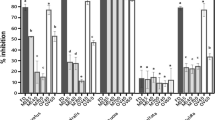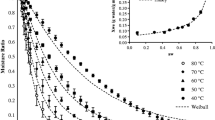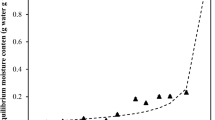Abstract
The effects of convective air-drying at 25, 40, and 70 °C and freeze-drying on the quality of the edible kelp Saccharina latissima to be used for food were investigated. Based on the analysis of the carbohydrate and amino acid profiles, as well as polyphenol, fucoxanthin, and ash contents, no significant differences were detected among sample groups, and air-drying up to 70 °C results in equally nutritious products at shorter processing times. Only the iodine content was found lower in freeze-dried compared to air-dried samples. The swelling capacity of the air-dried samples was significantly lower than in freeze-dried samples, particularly at high temperatures (40 and 70 °C), reflecting alteration of the physico-chemical properties of the seaweed during air-drying (attributed to product shrinkage) and reduced capacity of the final product to rehydrate. Structural differences between air-dried products at 25 and 70 °C may explain the differences in mouthfeel perception (dissolving rate) among the two sample groups observed during a sensory evaluation. Overall, the drying temperature within this range did not alter neither the aroma (i.e. odor) nor the flavor intensity of the product. In food applications where the product’s mechanical properties (e.g. porosity) are essential, freeze-drying, and to a lesser extent, air-drying at low temperatures, will result in higher quality products than air-drying at higher temperatures.



Similar content being viewed by others
References
Angell AR, Mata L, de Nys R, Paul NA (2016) The protein content of seaweeds: a universal nitrogen-to-protein conversion factor of five. J Appl Phycol 28:511–524
Bonazzi C, Dumoulin E (2011) Quality changes in food materials as influenced by drying processes. In: Tsotsas E, Mujumdar AS (eds) Modern drying technology, Volume 3: Product Quality and Formulation. Wiley-VCH Verlag, Weinheim Germany, pp 1–20
Chan JCC, Cheung PCK, Ang PO (1997) Comparative studies on the effect of three drying methods on the nutritional composition of seaweed Sargassum hemiphyllum (Turn.) C. Ag. J Agric Food Chem 45:3056–3059
Chapman AS, Stévant P, Emblem Larssen W (2015) Food or fad? Challenges and opportunities for including seaweeds in a Nordic diet. Bot Mar 58:423–433
Chel-Guerrero L, Perez-Flores V, Betancur-Ancona D, Davila-Ortiz G (2002) Functional properties of flours and protein isolates from Phaseolus lunatus and Canavalia ensiformis seeds. J Agric Food Chem 50:584–591
Cofrades S, López-López I, Solas MT, Bravo L, Jimenez-Colmenero F (2008) Influence of different types and proportions of added edible seaweeds on characteristics of low-salt gel/emulsion meat systems. Meat Sci 79:767–776
Cox S, Gupta S, Abu-Ghannam N (2012) Effect of different rehydration temperatures on the moisture, content of phenolic compounds, antioxidant capacity and textural properties of edible Irish brown seaweed. Food Sci Technol 47:300–307
Dawczynski C, Schubert R, Jahreis G (2007) Amino acids, fatty acids, and dietary fibre in edible seaweed products. Food Chem 103:891–899
Déléris P, Nazih H, Bard JM (2016) Seaweeds in human health. In: Fleurence J, Levine I (eds) Seaweed in health and disease prevention. Academic Press, Amsterdam, pp 319–367
Enríquez S, Duarte CM, Sand-Jensen K (1993) Patterns in decomposition rates among photosynthetic organisms: the importance of detritus C:N:P content. Oecologia 94:457–471
Fleurence J (2004) Seaweed proteins. In: Yada R (ed) Proteins in food processing. Woodhead publishing, Cambridge, pp 197–213
Fleury N, Lahaye M (1991) Chemical and physico-chemical characterisation of fibres from Laminaria digitata (kombu breton): a physiological approach. J Sci Food Agric 55:389–400
Fung A, Hamid N, Lu J (2013) Fucoxanthin content and antioxidant properties of Undaria pinnatifida. Food Chem 136:1055–1062
Girolami A, Napolitano F, Faraone D, Braghieri A (2013) Measurement of meat color using a computer vision system. Meat Sci 93:111–118
Gómez-Ordóñez E, Jiménez-Escrig A, Rupérez P (2010) Dietary fibre and physicochemical properties of several edible seaweeds from the northwestern Spanish coast. Food Res Int 43:2289–2294
Gupta S, Cox S, Abu-Ghannam N (2011) Effect of different drying temperatures on the moisture and phytochemical constituents of edible Irish brown seaweed. LWT - Food Sci Technol 44:1266–1272
Haugan JA, Liaaen-Jensen S (1994) Algal carotenoids 54. Carotenoids of brown algae (Phaeophyceae). Biochem Syst Ecol 22:31–41
Holdt SL, Kraan S (2011) Bioactive compounds in seaweed: functional food applications and legislation. J Appl Phycol 23:543–597
Horie Y, Sugase K, Horie K (1995) Physiological differences of soluble and insoluble dietary fibre fractions of brown algae and mushrooms in pepsin activity in vitro and protein digestibility. Asia Pac J Clin Nutr 4:251–255
Hou X, Feng X, Qian Q, Chai C (1998) A study of iodine loss during the preparation and analysis of samples using 131I tracer and neutron activation analysis. Analyst 123:2209–2213
Ikeda K (2002) New seasonings. Chem Senses 27:847–849
Indrawati R, Sukowijoyo H, Indriatmoko, Wijayanti RDE, Limantara L (2015) Encapsulation of brown seaweed pigment by freeze drying: characterization and its stability during storage. Procedia Chem 14:353–360
ISO:8586:1 (2012) Sensory analysis—general guidance for the selection, training and monitoring of selected assessors and expert sensory assessors. International Organization for Standardization, Geneva Switzerland, pp 28
ISO:13299 (2003) Sensory analysis—methodology—general guidance for establishing a sensory profile. International Organization for Standardization, Geneva Switzerland, pp 41
Kajiwara T, Hatanaka A, Kawai T, Ishihara M, Tsuneya T (1988) Study of flavor compounds of essential oil extracts from edible Japanese kelps. J Food Sci 53:960–962
Küpper FC, Carpenter LJ, McFiggans GB, Palmer CJ, Waite TJ, Boneberg E-M, Woitsch S, Weiller M, Abela R, Grolimund D, Potin P, Butler A, Luther GW, Kroneck PMH, Meyer-Klaucke W, Feiters MC (2008) Iodide accumulation provides kelp with an inorganic antioxidant impacting atmospheric chemistry. Proc Natl Acad Sci U S A 105:6954–6958
Lage-Yusty MA, Alvarado G, Ferraces-Casais P, López-Hernández J (2014) Modification of bioactive compounds in dried edible seaweeds. Int J Food Sci Technol 49:298–304
Lawless H, Heymann H (2010) Sensory evaluation of food: principles and practices, 2nd edition. Springer, New York
Lindsay R (2008) Flavors. In: Demodaran S, Parkin KL, Fennema OR (eds) Fennema’s food chemistry, 4th edition. CRC Press, , Boca Raton, pp 639–687
Ling ALM, Yasir S, Matanjun P, Abu Bakar MF (2015) Effect of different drying techniques on the phytochemical content and antioxidant activity of Kappaphycus alvarezii. J Appl Phycol 27:1717–1723
López-Pérez O, Picon A, Nuñez M (2017) Volatile compounds and odour characteristics of seven species of dehydrated edible seaweeds. Food Res Int 99:1002–1010
Lüning K, Mortensen LM (2015) European aquaculture of sugar kelp (Saccharina latissima) for food industries: iodine content and epiphytic animals as major problems. Bot Mar 58:449–455
MacArtain P, Gill CIR, Brooks M, Campbell R, Rowland IR (2007) Nutritional value of edible seaweeds. Nutr Rev 65:535–543
Marfaing H, Hemon E, Clement M-J, Sassi J-F, Lerat Y, Chevelot L, Daniel R (2009) Delineating the relationship between the structural features of algal fucoidan and brown seaweed species. Paper presented at the Polymerix, 4th international symposium: biopolymers diversity and industrial applications perspectives, Rennes, France, 28–29 May, 2009
Marinho GS, Holdt SL, Angelidaki I (2015) Seasonal variations in the amino acid profile and protein nutritional value of Saccharina latissima cultivated in a commercial IMTA system. J Appl Phycol 27:1991–2000
Michel F, Priol J, Galaup P, Demaimay M, Bigot C (1997) Effet de deux techniques de séchage sur les composés volatils de deux algues alimentaires Ulva sp et Palmaria palmata. Sci Aliments 17:601–617
Miyai K, Tokushige T, Kondo M (2008) Suppression of thyroid function during ingestion of seaweed “kombu” (Laminaria japonica) in normal Japanese adults. Endocr J 55:1103–1108
Moreira R, Chenlo F, Sineiro J, Arufe S, Sexto S (2016) Drying temperature effect on powder physical properties and aqueous extract characteristics of Fucus vesiculosus. J Appl Phycol 28:2485–2494
Mouritsen OG (2017) Those tasty weeds. J Appl Phycol 29:2159–2164
Mouritsen OG, Williams L, Bjerregaard R, Duelund L (2012) Seaweeds for umami flavour in the New Nordic Cuisine. Flavour 1:4
Murata M, Nakazoe J-I (2001) Production and use of marine algae in Japan. Jap Agric Res Quart 35:281–290
Mæhre HK, Malde MK, Eilertsen KE, Elvevoll EO (2014) Characterization of protein, lipid and mineral contents in common Norwegian seaweeds and evaluation of their potential as food and feed. J Sci Food Agric 94:3281–3290
Ninomiya K (2002) Umami: a universal taste. Food Rev Int 18:23–38
Nitschke U, Stengel DB (2015) A new HPLC method for the detection of iodine applied to natural samples of edible seaweeds and commercial seaweed food products. Food Chem 172:326–334
Nitschke U, Stengel DB (2016) Quantification of iodine loss in edible Irish seaweeds during processing. J Appl Phycol 28:3527–3533
Osnes KK, Mohr V (1985) Peptide hydrolases of Antartic krill, Euphausia superba. Comp Biochem Physiol B 82:599–606
Quemener B, Marot C, Mouillet L, Da Riz V, Diris J (2000) Quantitative analysis of hydrocolloids in food systems by methanolysis coupled to reverse HPLC. Part 1. Gelling carrageenans. Food Hydrocoll 14:9–17
R Development Core Team (2017) R: a language and environment for statistical computing. R Foundation for Statistical Computing, Vienna, Austria
Ragan MA, Glombitza KW (1986) Phlorotannins, brown algal polyphenols. Prog Phycol Res 4:130–230
Rioux L-E, Beaulieu L, Turgeon SL (2017) Seaweeds: a traditional ingredients for new gastronomic sensation. Food Hydrocoll 68:255–265
Roleda MY, Skjermo J, Marfaing H, Jónsdóttir R, Rebours C, Gietl A, Stengel DB, Nitschke U (2018) Iodine content in bulk biomass of wild-harvested and cultivated edible seaweeds: inherent variations determine species-specific daily allowable consumption. Food Chem 254:333–339
Rupérez P, Saura-Calixto F (2001) Dietary fibre and physicochemical properties of edible Spanish seaweeds. Eur Food Res Technol 212:349–354
Sappati PK, Nayak B, van Walsum GP (2017) Effect of glass transition on the shrinkage of sugar kelp (Saccharina latissima) during hot air convective drying. J Food Eng 210:50–61
Schiener P, Black KD, Stanley MS, Green DH (2015) The seasonal variation in the chemical composition of the kelp species Laminaria digitata, Laminaria hyperborea, Saccharina latissima and Alaria esculenta. J Appl Phycol 27:363–373
Stévant P, Marfaing H, Duinker A, Fleurence J, Rustad T, Sandbakken I, Chapman A (2017a) Biomass soaking treatments to reduce potentially undesirable compounds in the edible seaweeds sugar kelp (Saccharina latissima) and winged kelp (Alaria esculenta) and health risk estimation for human consumption. J Appl Phycol. https://doi.org/10.1007/s10811-017-1343-8
Stévant P, Marfaing H, Rustad T, Sandbakken I, Fleurence J, Chapman A (2017b) Nutritional value of the kelps Alaria esculenta and Saccharina latissima and effects of short-term storage on biomass quality. J Appl Phycol 29:2417–2426
Stévant P, Rebours C, Chapman A (2017c) Seaweed aquaculture in Norway: recent industrial developments and future perspectives. Aquacult Int 25:1373–1390
Tello-Ireland C, Lemus-Mondaca R, Vega-Gálvez A, López J, Di Scala K (2011) Influence of hot-air temperature on drying kinetics, functional properties, colour, phycobiliproteins, antioxidant capacity, texture and agar yield of alga Gracilaria chilensis. LWT - Food Sci Technol 44:2112–2118
Wang T, Jónsdóttir R, Liu H, Kristinsson HG, Raghavan S, Ólafsdóttir G (2012) Antioxidant capacities of phlorotannins extracted from the brown algae Fucus vesiculosus. J Agric Food Chem 60:5874–5883
Wells ML, Potin P, Craigie JS, Raven JA, Merchant SS, Helliwell KE, Smith AG, Camire ME, Brawley SH (2017) Algae as nutritional and functional food sources: revisiting our understanding. J Appl Phycol 29:949–982
WHO/FAO/UNU (2007) Protein and amino acid requirements in human nutrition. WHO Technical Report Series. Report of a joint WHO/FAO/UNU expert consultation
Wong KF, Cheung PC (2001a) Influence of drying treatment on three Sagassum species 1. Proximate composition, amino acid profile and some physico-chemical properties. J Appl Phycol 13:43–50
Wong KF, Cheung PC (2001b) Influence of drying treatment on three Sagassum species 2. Protein extractability, in vitro protein digestability and amino acid profile of protein concentrates. J Appl Phycol 13:51–58
Yam KL, Papadakis SE (2004) A simple digital imaging method for measuring and analyzing color of food surfaces. J Food Eng 61:137–142
Acknowledgements
The authors gratefully acknowledge Jorunn Skjermo and SINTEF Ocean’s seaweed cultivation team for providing the biomass, Veronica Hammer Hjellnes for the free amino acid characterization of the samples, Turid Fylling Standal for the analysis of the samples physico-chemical properties (WBC, OBC, SC), and panel members from Møreforsking Ålesund AS, who participated to the sensory evaluation of the samples.
Funding
This work was conducted as part of the PROMAC project (244244), funded by the Research Council of Norway, and part of the Sustainable Innovation in Food- and Bio-based Industries Programme. Pierrick Stévant was supported by a doctoral fellowship from Sparebanken Møre.
Author information
Authors and Affiliations
Corresponding author
Electronic supplementary material
ESM 1
(PDF 471 kb)
Rights and permissions
About this article
Cite this article
Stévant, P., Indergård, E., Ólafsdóttir, A. et al. Effects of drying on the nutrient content and physico-chemical and sensory characteristics of the edible kelp Saccharina latissima. J Appl Phycol 30, 2587–2599 (2018). https://doi.org/10.1007/s10811-018-1451-0
Received:
Revised:
Accepted:
Published:
Issue Date:
DOI: https://doi.org/10.1007/s10811-018-1451-0




